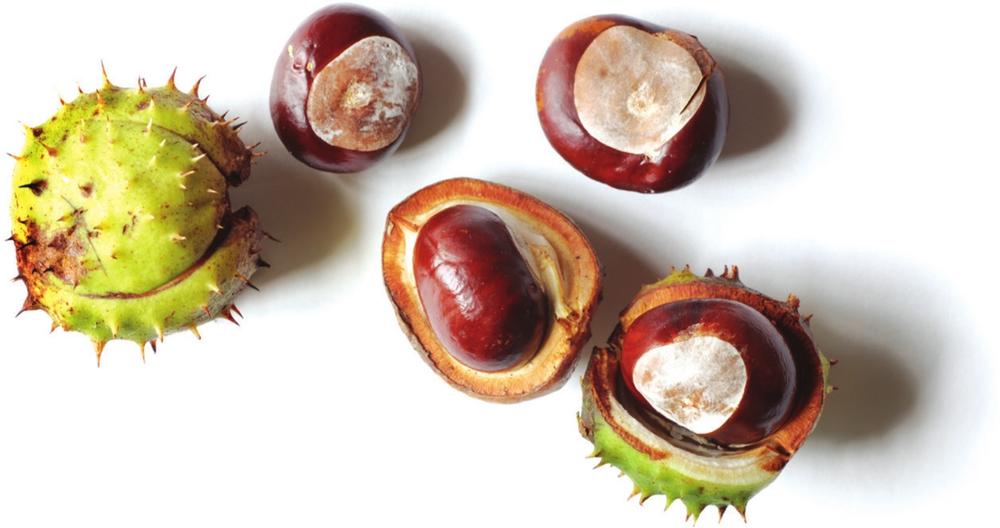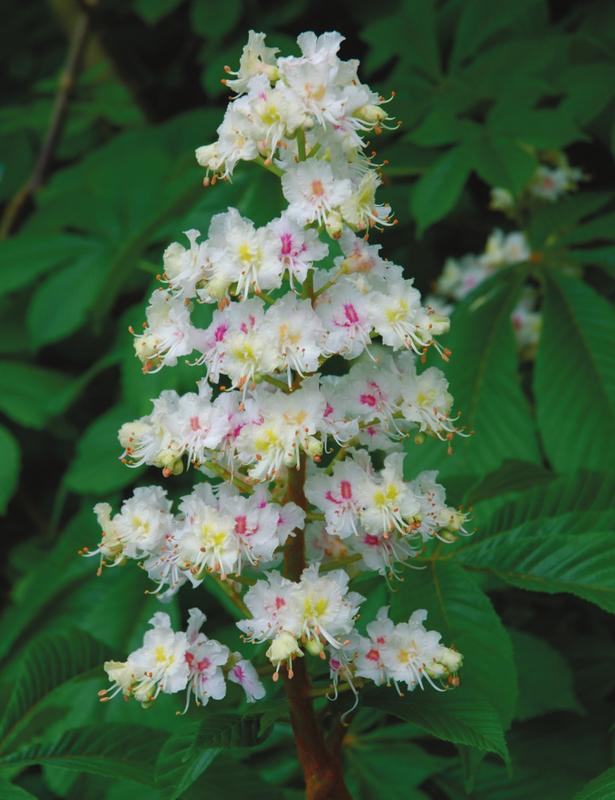
Familiar for its conkers, horse chestnut has been one of Britain’s favourite ornamental trees for the last four centuries. It also has significant medicinal uses, particularly for supporting weakened veins, as in varicose veins, haemorrhoids and capillary fragility. It is used for two Bach Flower Essences and in commerical quantities for allopathic and homeopathic remedies for irregularities of the veins. It also has some surprising other uses.

Sapindaceae Horse chestnut family
Description: A tall tree, up to 40m, with palmate leaves in spring and huge candelabras of white–pink flowers in summer, followed by conkers in autumn.
Habitat: Hedgerows, parks and roadsides.
Distribution: It is widespread as a planted and naturalised species.
Related species: The red horse chestnut (A. carnea) is frequently planted in towns and parks, and is used as a flower essence. Horse chestnut is unrelated to sweet chestnut (Castanea sativa).
Parts used: Conkers, collected in autumn; leaves in spring.
A shapely tree, with glossy brown sticky buds in winter, lime green hand-shaped leaves in spring, then soft and frothy Folies-Bergère-like pink and white flowers in summer, and hard spherical auburn nuts, conkers, in autumn – no wonder the all-season beauty of horse chestnut was such a hit when the tree was introduced into England in the early 1600s.
At first a tree of kings and owners of great estates, it later came to belong to everybody as Britain’s municipal tree of choice, planted ornamentally in every avenue and park, in every Chestnut Villas of every Victorian city.
Recent estimates of the national horse chestnut ‘park’ give a figure of over 400,000 trees. It was and is admired for its looks – the wood of horse chestnut is soft and spongy, poor for carpentry or building.
The tree’s scientific and popular names may derive from its use in Turkey, one of the countries of origin of the first specimens to reach Western Europe. The Turks mixed flour from the conkers with oats to improve the breathing of broken-winded horses.
Other plant historians suggest that ‘horse’ is meant as a derogative comparison to the native and tasty sweet chestnut (which is unrelated botanically). Horse chestnut conkers do contain a complex bitter chemical, aescin (escin in US spelling), as the plant’s active principle, and this is said to be toxic to humans in very large quantities.
Surprisingly varied uses have been found for the tree. The bark was used as a quinine substitute for malaria and other fevers, while the flower buds made an ersatz flavouring for beer. Conkers produce a good soapy lather for shampoo and to clean clothes, stop mould and repel clothes moths.

And, little known today, conkers were used for explosives during the First World War. With other sources of acetone unavailable, British children collected 3,000 tons of conkers secretly in summer 1917 (their schools received a certificate). The research chemist seconded to the government’s chestnuts plan, Chaim Weizman, then in Manchester, would become first president of Israel in 1948.
Other new ‘explosive’ chestnut issues include worries about a leaf miner moth damaging (but not killing) mature trees, and the charge that children are at risk while playing with conkers if they chew or eat them. Sadly, the game is now banned in some English schools, but it would need concerted force-feeding to reach toxic levels of aescin, and the bitter taste is already off-putting to children.
Use horse chestnut for…
Horse chestnut is a leading herbal treatment for weakened veins, including varicose veins, haemorrhoids, acne rosacea and chronic venous insufficiency (CVI). It has an unusual capacity to strengthen small blood vessel walls by reducing the size and number of the pores; it also works well on wrinkles by tightening the skin (an alternative to Botox, perhaps?), and for fluid retention or oedema.
Horse chestnut is taken both internally as a tincture and externally as a cream, oil or lotion. Internal use should be in small doses and under the supervision of a herbalist, in case of stomach irritation. Commercially, it is grown for horse chestnut seed extract (HCSE) and a homeopathic remedy. It also makes two Bach Flower Essences, chestnut bud and white chestnut.

Conker tincture
Collect the conkers as soon as they fall to the ground in early autumn. They will usually come out of their green spiky husks by themselves. While fresh, they are quite soft, but they soon harden and are much more troublesome to cut. Use a serrated knife and be careful in chopping them up, as they can skid out from under the knife blade.
Put the chopped conkers in a jar and pour in enough vodka to cover them. Leave in a dark cupboard for a month, shaking every few days. It is normal for the alcohol to extract a milky sediment from the seeds. Strain and bottle, or use to make the lotion below.
Internal use: 5 drops in water twice a day, or as recommended by your herbalist.
Horse chestnut leaf oil
Pick leaves in spring before the flowers open. Chop them up and put them in a jar large enough to hold them. Fill the jar with extra virgin olive oil. Stir to remove any air bubbles, and top up with more oil if necessary. Put on a sunny windowsill to infuse for a month, then strain off the oil into a jug. Allow this to settle for half an hour. Carefully pour the oil into jars, leaving any watery sediment behind at the bottom of the jug. Apply directly to the skin or use to make the lotion below.
Horse chestnut lotion
Chill equal amounts of conker tincture, horse chestnut leaf oil and castor oil in the fridge overnight, then blend until creamy. Bottle. Shake well before use, as it may separate on standing. Apply twice a day.
